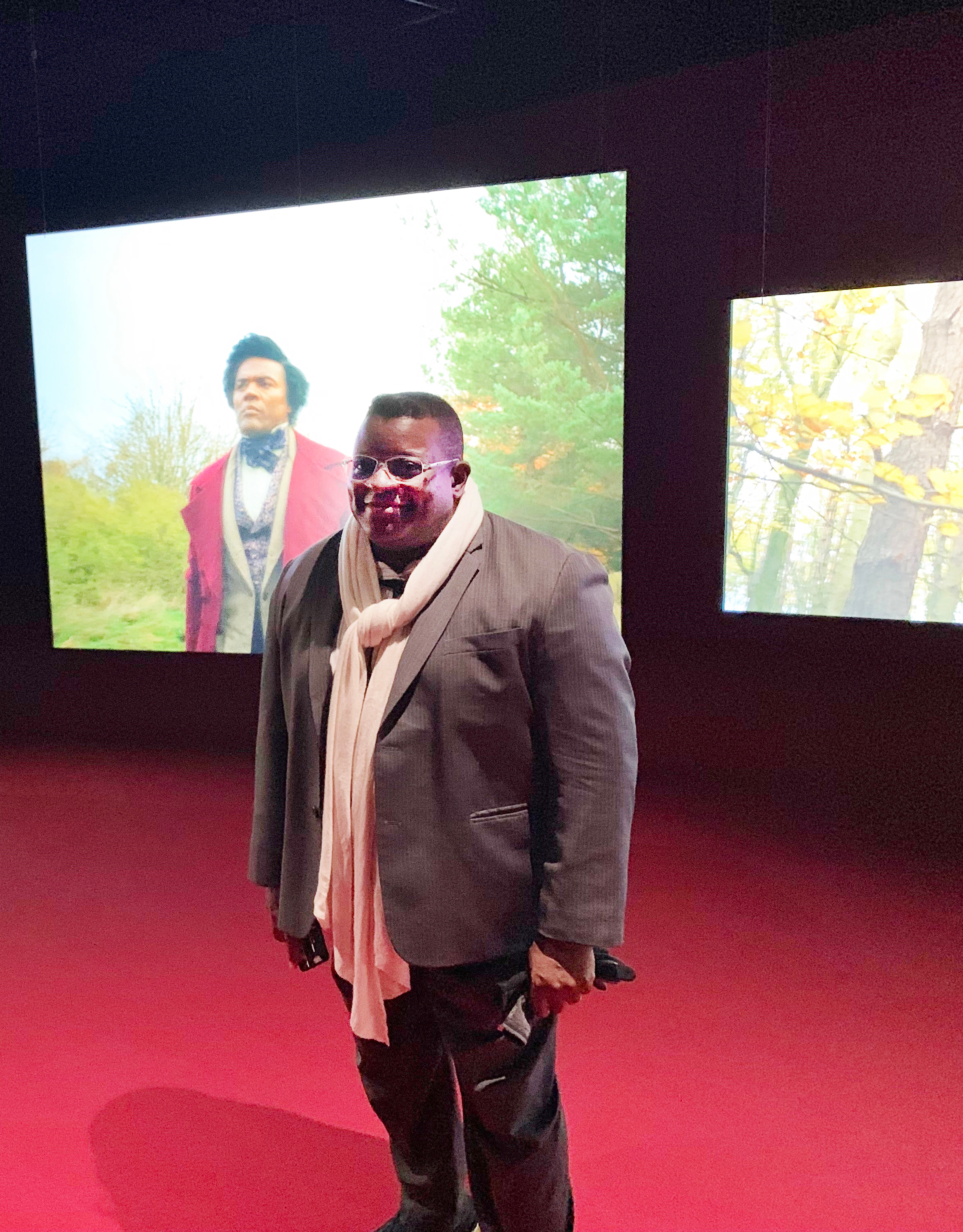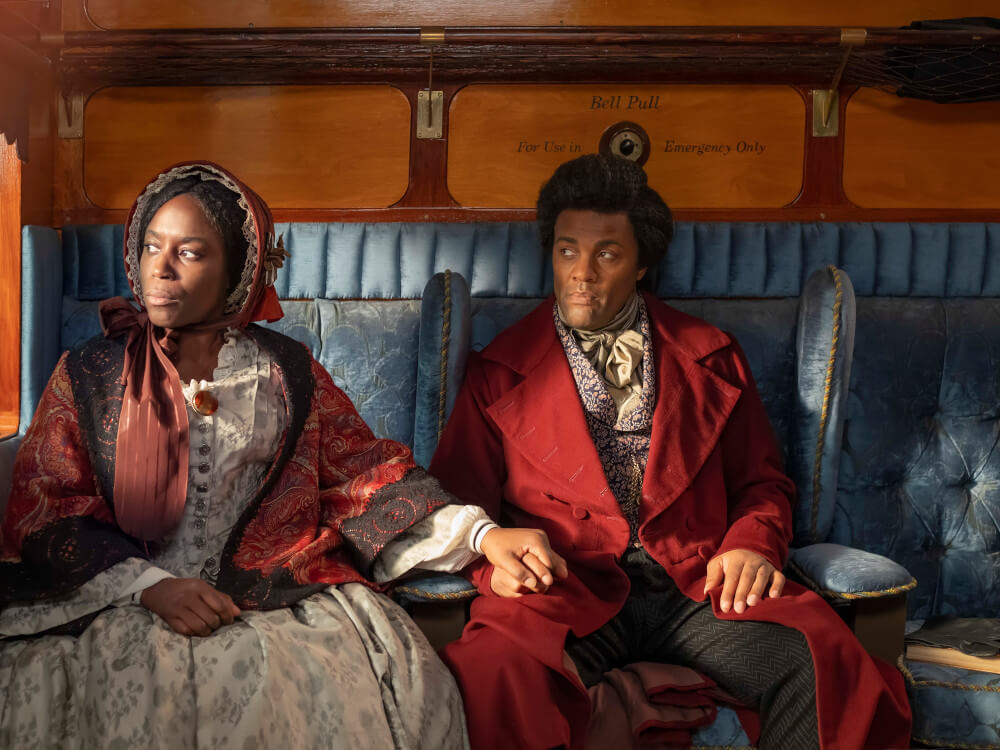
Living history
New media art connects past to present with archival material
The 19th-century visionary and orator Frederick Douglass established his place in history by chronicling his life as a series of revealing events: enslaved childhood, self-education, escape, and an unending fight for justice and equality. Douglass’s remarkable life provides a powerful canvas for the multifaceted, archive-based art of UC Santa Cruz distinguished professor of the arts Isaac Julien. Using innovative new and emerging media techniques and technologies that bring his historical subjects to life, Julien aims for others to see them—now including the lifelong activist Douglass—as he does, through a lens of 21st-century sensibility and perspective.

“I’m very interested in how we can look at these past figures and contemporize them for a whole new audience,” said the moving-image artist, known globally for his path-breaking work in films and video installation. To do this in the recently exhibited Lessons of the Hour—Frederick Douglass, Julien included disparate elements, sometimes all simultaneously: visualizations of the famous abolitionist in some of his most poignant moments, broadcasts of his oratory that resonate with today’s issues, and displays of movement surrounding Douglass that can be soothing, intriguing, and even jarring. The intent, Julien said, is to utilize new media and cinema technologies, along with new archival research and understandings, “to create an active relationship between past and present, as a way of commenting on the moment that we inhabit.”
The result is a compelling mesh of past and present that provokes the audience to consider possible connections between the two. This type of engagement is one of the hallmarks of Julien’s work, which spans decades and covers widely varying social and cultural subjects, including the Harlem Renaissance poet Langston Hughes in the film Looking for Langston (1989) and the crisis of migration into Europe in his work Western Union Small Boats (2007). “Isaac has a way of synthesizing our understanding of the past that brings its relevance into the present and helps us to understand how we all connect in the context of history,” said Jonathan Binstock, director of the University of Rochester’s Memorial Art Gallery, during a public talk about the Douglass exhibition.

Lessons of the Hour project curator John Hanhardt described Julien’s work as a type of “philosophical cinema” that brings ideas, issues of representation and understanding, and knowledge as a kind of fluid movement between memory and direct experience. “This is not a linear narrative projected on a single screen. It’s 10 screens—different positions, sizes—where you follow the action and are shaped by the action, just as you are shaped by the visual experiences you have in your daily life.”
Born in London to parents from Saint Lucia in the Caribbean, Julien previously had limited exposure to Douglass, except for what he had discovered while on a teaching appointment (1998–2002) at Harvard University. To begin the project, commissioned in 2017 by the Memorial Art Gallery as part of an initiative to build its collection of moving images and also supported by UCSC, Julien explored Rochester—Douglass’s longtime home in New York—and dove into the university’s archives. He and his assistants scoured old books, papers, magazines, drawings, and photographs, searching for clues to a deeper understanding of Douglass and his time. Julien found “there was this inner Douglass world that was fascinating.” He also uncovered a “symbiotic relationship” with Douglass while reading the activist’s “Lecture on Pictures.” Called the most photographed American of the 19th century, Douglass, like Julien, was fascinated by photography and its power to influence others.
Shaking the dust off
The process that Julien uses for his work is the basis for a new lab he and longtime collaborator and partner Mark Nash, professor of film and digital media, have established on campus. The Isaac Julien Lab (IJ Lab), modeled in part after Julien’s London studio, prizes the use of archival material as an intrinsic part of the creative method. It also intentionally addresses the university’s three academic priorities: Justice in a Changing World, Digital Interventions, and Earth Futures. Its first crop of students in a Master of Fine Arts program, to begin in fall of 2020, will be asked to propose a project that involves one or more of these themes. For Julien’s work in particular, issues of social justice are a common thread.
With its history of inventive thinking in its Humanities and Arts Divisions, UCSC makes sense as a place for a new media lab that prides itself on developing ideas and artistic innovations that will “shake the dust off” traditional ways of creating and viewing art, said Julien. In addition, its proximity to the San Francisco Bay Area’s technological innovations and world-class art collections, such as the Kramlich Collection of media art and the Joyner/Giuffrida Collection of abstract art, provides vital pools of creativity. This wealth of resources, Julien said, can stimulate younger people who want to become artists, as well as those interested in the business aspects of art, helping to shape a “type of entrepreneurial creator who is able to navigate the art world as it’s constituted today.”
In a good example of the practical experience students can expect to gain, those enrolled in one of Julien’s spring classes were slated, before the Covid-19 shutdown, to help with the October 2020 launch of a new installation of Lessons of the Hour at the McEvoy Foundation for the Arts in San Francisco. The collaboration was intended to expose students to various aspects of producing an exhibition, such as helping to organize and set up the gallery space, and tackling the intricacies of a complex installation that involves many complicated digital technologies. UCSC students had a similar engagement with the Douglass project in 2019, said Nash, when “production of the single-screen version of the work introduced some students to a specialized editing and sound process, and gave them access to Julien’s expert collaborators.” That version of Lessons of the Hour was exhibited at Art Basel in Miami Beach in December 2019.
Past is present
Combining gallery pieces and film on multiple screens, the original Douglass exhibition provides a vivid illustration of the complex work that goes into creating these media projects. Julien and his team not only researched Douglass and influential people in his life using archival materials, they consulted with Douglass scholar Celeste-Marie Bernier, and investigated historical photographic processes, and settings and sounds of the past. To learn more about how photographs were made at the time, for instance, they turned to experts at the George Eastman Museum, located on the photography and motion picture film pioneer’s Rochester estate. Tintype specialists guided them in the creation of authentic photographs similar to those of the Douglass era. Royal Shakespeare Company actor Ray Fearon, who portrayed Douglass, took lessons so he would speak with the correct accent as he gave life to sections of Douglass’s autobiography and excerpts from three of his hundreds of lectures delivered across the country and in the United Kingdom: “Lessons of the Hour,” “What to the Slave Is the 4th of July?,” and “Lecture on Pictures.” A combination of environmental sounds, such as the sharp lashing of a whip, and original scoring inspired by music of the time fill the space around Douglass’s words. For backdrops, Julien and his team created sets based on their research and traveled to key shooting locations such as Scotland, where Douglass had exiled himself from 1845–1847 until supporters raised $711.66 to buy his freedom.

Julien’s work reminds his audiences that issues and struggles of the past, such as the fight for equality and social justice, continue to play out. One example is when the actor Fearon, as Douglass, addresses an audience seated in a Royal Academy of Arts lecture hall. Members dressed in both contemporary and 19th-century clothing listen intently as Douglass delivers passages from “What to the Slave Is the 4th of July?” At the same time on other screens around the room, aerial drone shots emerge of modern-day Baltimore, the site of the 2015 Freddie Gray protests and riots that fueled the Black Lives Matter movement against violence and systemic racism.
Striking the right tone and making Douglass come alive for today’s audiences was a demanding undertaking, said Julien, in part because of Douglass’s formidable historic stature. “The biggest challenge was to make a work that would be convincing. He’s a very tall order.” In his time, Douglass proved to be a powerful and indefatigable man of influence in the fight against slavery and for equality and justice, and his legacy continues more than 200 years after he was born. “There is a strong connection between the kind of quest that Douglass was demanding and striving for and, if you like, the unfinished business of these issues in the 21st century,” Julien said.

Douglass’s great-great-great grandson Kenneth B. Morris, Jr., saw this connection as well when he cofounded the Atlanta-based nonprofit Frederick Douglass Family Initiatives. The organization’s efforts focus on modern-day slavery and the global problem of human trafficking. “When you look at slavery today there are many parallels to historic slavery,” Morris has said. “It’s about profit. It’s about exploiting the most vulnerable among us.” Morris now leads the fight for freedom in the same way as his famous distant relative, through education. Julien said that meeting Morris and hearing his reaction to Lessons of the Hour—he told Julien he was “extremely moved”—made him feel like he had been successful in making Douglass come to life in a meaningful way. “As an artist, you have a responsibility for how you are going to translate feelings, words, and actions, and do them justice.”

